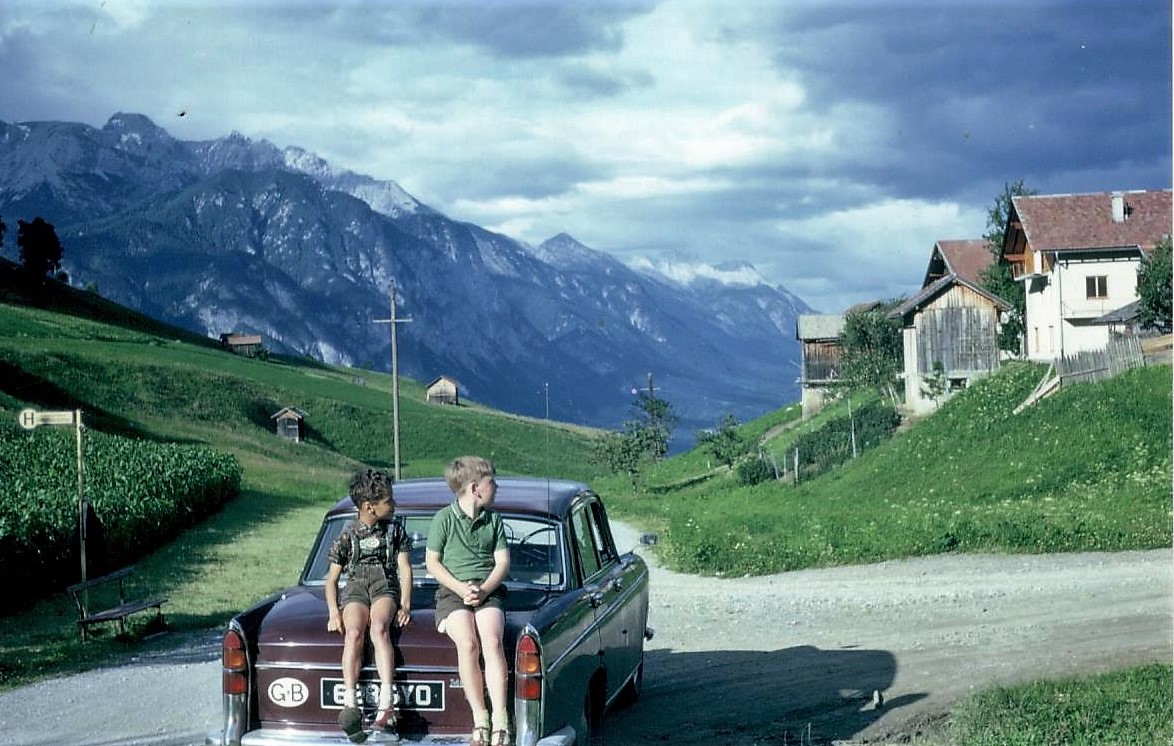An 8-day drive around Germany and Austria
Thinking about it, I suppose I have always been a bit of a petrolhead. Ever since my Dad’s first 1956 Morris Oxford, when I was knee high to a grasshopper, I took an interest in cars and also in overseas travel. Long before package deals were dreamed of, my Dad, my German mother, my brother and I would pile into the family saloon to visit long-lost relations and acquaintances on the other side of the channel.
In the early 1960s, travelling to Europe was an adventure. We had a fully loaded motor car complete with numerous maps, a Camping Gaz stove and a Primus burner together with gas cylinders, cans of Heinz baked beans and sausages, tins of potatoes and gifts for Uncle Kurt and Auntie Inge, upon whom we were about to descend for our annual pilgrimage to the motherland.
 Uncle Kurt and Auntie Inge lived near the VW factory in Wolfsburg and highlights of the trip usually included a visit to see Beetles being built, and a trip into the Harz mountains. Part of the fun was boarding ship with the car and setting sail to this strange country and beyond, where people speak a different language and eat sausage.
Uncle Kurt and Auntie Inge lived near the VW factory in Wolfsburg and highlights of the trip usually included a visit to see Beetles being built, and a trip into the Harz mountains. Part of the fun was boarding ship with the car and setting sail to this strange country and beyond, where people speak a different language and eat sausage.
The other day, I was looking at our home collection of slides—remember them? —now on disc. I remember a trip for two weeks in 1961 when we visited Holland, Germany, Austria, Switzerland and Italy, ending up in Venice at the Lido. The highlight of the trip was seeing a car in Brescia outside our hotel that was competing in the Mille Miglia. From the photo it looked very much like a Ferrari 250GT.
Of course, with car ownership and the freedom of the open road came car troubles and the misery of roadside repairs. A holiday could be spoiled by the alarming rattle of some vital engine component working loose, the disheartening rumble of a flat tyre or steam coming out of somewhere beneath the bonnet.The bonnet was often up to help it cool down, my Dad used to say.
We travelled often into Berlin, my Mother’s birthplace, via the DDR before the wall was both put up and later torn down, travelling down what I have now learned is the A2 E30 corridor. I remember having a puncture en route. Dad was pretty used to it on those cobbled stones; he was good at changing the wheel on the side of the Autobahn, getting the jack into position and putting the spare onto the hub. On one occasion, the Volkspolizei (cops) from East Germany pulled alongside. They got inside the car, startling us all by trying to pull it apart to check for any stray wannabe emigrants in the boot and underneath. All they found was a load of baked beans and spuds.They were pretty scary in uniform and made it very clear that we should not stop and get moving straight away. Dad fixed it in record time and shot off, leaving the hub cap behind. When we reached Berlin and stopped after hearing strange sounds coming from the rear wheel, he became furious with himself for having succumbed to a couple of Stasi-type Commies, making him forget the precious hub cap.
Wind the clock on 50 years or so to 2020, at the start of this year and pre-Coronavirus, I got a call from a good friend of mine, Norbert. He is a former business associate and fellow Jaguar XK-owner, and was keen to secure a companion for his pride and joy on a road trip through Bavaria and into the Austrian Tyrol. It would end up on the Großglockner Hoch Alpine Pass, some 2500m (8500 ft) above sea level, thought by many to be one of the world’s best scenic drives. As my own pride and joy had just been replaced by a 2013 Jaguar XK variant in British Racing Green and I needed to ‘run it in’, I booked the ferry crossing on an open return basis. Little did I know that Covid-19 would kick off soon after.
 Norbert contacted me at the start of July to tell me that Germany and Austria had opened up and he was going ahead with the expedition. Did I still fancy it’? Having running out of ideas during lockdown, and wondering what the new tomorrow on the continent had in store, I jumped at the chance of letting the big cat loose on the Autobahn and beyond, and I readily accepted. A great opportunity to road test the finest Grand Tourer to come out of Coventry since Lady Godiva.
Norbert contacted me at the start of July to tell me that Germany and Austria had opened up and he was going ahead with the expedition. Did I still fancy it’? Having running out of ideas during lockdown, and wondering what the new tomorrow on the continent had in store, I jumped at the chance of letting the big cat loose on the Autobahn and beyond, and I readily accepted. A great opportunity to road test the finest Grand Tourer to come out of Coventry since Lady Godiva.
Day 1. At the end of July, and armed with my essential face mask and Sat Nav system, I packed my bag and drove the 44 miles to Harwich International Port and boarded the Stena Brittanica en route to the Hook of Holland. A far cry away from the crane method of entry used in 1961.
Suitably refreshed after a good night’s sleep in my single suite cabin, I was woken up at the Hook, just outside Rotterdam, ready for a day’s drive ahead. The first night I spent at Augsburg, at Norbert’s home, just an hour from Munich and 480 miles from Chelmsford.
Driving on the Autobahns of southern Germany just feels like normal, only faster than in the fifties and sixties, and on the other side of the road. Definitely brown trousers at the ready and squeaky bum time, it takes a little adjustment, especially when you are being hotly pursued by an Opel Astra with the driver’s foot prodding the floorboard, a contraflow looming up ahead and a lorry pulling out. You do wonder whether the brakes on the car behind will make it.
 Keeping to a steady 80-90 mph, with the occasional burst of speed keeping the adrenalin and testosterone level suitably lubricated, helps curiosity and I am pleased to say that the Jag swallowed up the kilometres with ease and in comfort.
Keeping to a steady 80-90 mph, with the occasional burst of speed keeping the adrenalin and testosterone level suitably lubricated, helps curiosity and I am pleased to say that the Jag swallowed up the kilometres with ease and in comfort.
Day 2. Setting off early, we negotiated the Munich ring, driving past the Allianz Arena, the home of Bayern Munich, and headed for Berchtesgaden, the former home of National Socialism and summer home of the Führer, one Adolf Hitler, at the Eagle’s Nest. Now little remains of it apart from a museum and a memorial to reflect on this beautiful Alpine village and the historical aspects of war. It seems that the Führer was a questionable visionary who just went too far down the dictatorship route. He operated a murderous, psychopathic, serial-killer regime, but he did also instigate a couple of sensible ideas in building a road network system that was years ahead of its time, and creating the concept of a people’s car to go on it, the VW Beetle.

 Late afternoon was spent high on the heels of a lonely goatherd, high above the village and overlooking the Hotel zum Türken, a notorious watering hole frequented by Martin Bormann, Hermann Göring and Adolf Hitler. A secret tunnel connected to the Berchtesgaden bunker and it was a well known meeting place. My Jag had pride of place in front of the same until James Dean’s Porsche 356 convertible came along and blocked the view.
Late afternoon was spent high on the heels of a lonely goatherd, high above the village and overlooking the Hotel zum Türken, a notorious watering hole frequented by Martin Bormann, Hermann Göring and Adolf Hitler. A secret tunnel connected to the Berchtesgaden bunker and it was a well known meeting place. My Jag had pride of place in front of the same until James Dean’s Porsche 356 convertible came along and blocked the view.
Driving on from there across the border into Austria we came across the scenic Rossfeld, where part of the film Sound of Music was shot. This was alleged to be in the same vicinity that the von Trapp family villa was located. Julie Andrews (or Mary Poppins), who played Maria von Trapp, and Christopher Plummer would have been impressed that we visited it some 50 years later.
After a short break admiring the scenery, we headed via Innsbruck and Zell sam See to the Gasthof Post in Bruck an der
Großglocknerstraße, our base for the evening. A few large Edelweiss beers and a pork Schnitzel later for dinner rounded off a great day.

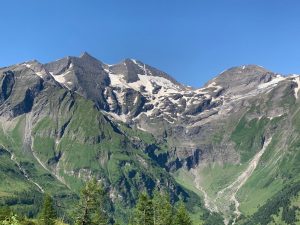 Day 3. The next day was a short journey from Bruck onto our featured scenic drive, the 48-kilometre Großglockner-
Day 3. The next day was a short journey from Bruck onto our featured scenic drive, the 48-kilometre Großglockner-
Hochalpensrtaße (high Alpine road). This is the highest surfaced mountain pass road in Austria. Named after the Gross Glockner, Austria’s highest mountain, it was built in the early 1930s, just after the New York stock market slump, which shook an impoverished Austria with terrible force. Austria had suffered catastrophic economic results through losing the First World War, and had seen devastating Inflation and unemployment of over 26 percent. Construction of the road was seen as a way of giving work to 3,200 men (from an average of 520,000 jobless at the time). Although the idea was mocked, it was also seen as a way of creating international tourist traffic’, in the belief that some 120,000 visitors a year might come. The state advanced the building costs and users of the road would pay off this sum through tolls. Little did they realise that, 90 years later, this road would be accommodating around 350,000 tourists a year by car and a further 500,000 by motorcycle and bicycle.
The road starts in Bruck in the state of Salzburg and ends in a place called Heilegenblut (meaning Holy Blood). With its 36 hairpin bends and its 2,500-metre backdrop, looking down with the soft top open is enough to drain anyone’s blood supply.

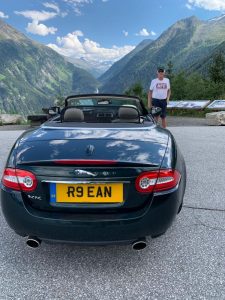
 The toll was 33 euros and the big cat, with its 5-litre V8 lump and paddleshift gearbox, handled the curves and climb up to its highest point, the viewpoint at Edelweißspitze, with ease. The scenery was truly breathtaking and worthy of accolade as the country’s, if not the continent’s, most beautiful mountain pass road.
The toll was 33 euros and the big cat, with its 5-litre V8 lump and paddleshift gearbox, handled the curves and climb up to its highest point, the viewpoint at Edelweißspitze, with ease. The scenery was truly breathtaking and worthy of accolade as the country’s, if not the continent’s, most beautiful mountain pass road.
We passed lots of exotic cars on the journey but probably the most interesting was the 1942 VW Kubelwagen, a military vehicle, with its Weimar Republic plates. Based on Hitler’s Beetle designed by Ferdinand Porsche, it had an air-cooled engine of 985cc knocking out just 23 hp and mounted behind the passenger compartment. The engine had no radiator, thus making it less susceptible to gunfire or shrapnel. Clever, those Germans, even then!
That evening was spent at the GurgItal Hof Hotel in Tarrenz, in the heart of the Tirol famous for its mountains, ski slopes and toboggan runs. Fortunately there was no snow, just 34 degrees of sunny mountain air. Another 208 miles covered and ready for a couple more Edelweiß beers and a veal Wiener Schnitzel this time. Both Norbert and I remarked upon the relaxed mood of Austrians compared to the Germans. No social distancing or face masks here in the hotel, nor in the supermarkets. A trifle worrying perhaps, or was it just down to more regular testing on a larger scale?
Day 4. The midway point of the trip was spent in transit back to Augsburg and some 180 miles were covered, finishing the day at Norbert’s retirement project in Binswangen. This is a classic car storage facility accommodating his own fleet of 10 vehicles and vintage motorcycles. Since my last visit in 2019, he has put in a mezzanine level, doubling up on floor space, with a lift system allowing him to accept another 10 collected vehicles in a closed dry garage with underfloor heating, air purifiers and a dust- proofing course that provides a healthy and clean environment.


The Jaguar XKR that Norbert uses in summertime is a 1997 model in royal blue with ivory leather and has just 120,000 kilometres/75,000 miles on the clock. The electric fan cutting in is his only complaint; it doesn’t do hill climbs without a little rest and its bonnet needs to come up in the process. According to Norbert, it is a pleasure to drive but it “likes a drink” of unleaded. 1,124 miles were now completed on the Croxson Jagfest Rock Tour, with another four days to go advancing on to the Berlin scenes of my yesteryear.
Day 5. After four days spent in transit between Germany and Austria, getting a good night’s rest in Augsburg was essential. After several large beers and local firewater the night before, an early start was required to get to my next point in Berlin. I set off in the direction of Donauworth and then via Audi Ville (Ingolstadt) and onto the A9 via Bayreuth (scene of the opera), Leipzig (which the Allies really hit hard during WW2) and then onto Berlin.
I can’t help but think back to the ’60s as part of the baby Boomer era to recall how different and unusual it was, and how privileged we were, in being able to travel by car into Eastern Germany. At that time there were several restrictions, including the English Channel taking some three hours to cross with infrequent and cancelled sailings. We also faced paying transit fees of DM5 in Germany after endless queues waiting to get the documentation sorted. Now, it is totally different; in the baby Beemer era, we think nothing of an M3 chasing a British-registered XK in a completely derestricted zone. A far cry away from having to lean forward to reach the 1955 Morris Oxford’s top speed of 74mph and a 0-62mph time of just over 31 seconds, and praying that the Morris would not break down or run out of fuel as petrol stations were few and far between.
As a family, we were fairly comfortable travelling via the GDR (German Democratic Republic) as the AA had introduced its 3- or 5-star recovery service through an alliance with the ADAC; that is, until we realised that in East Germany you were on your own.
Dad was always relaxed on holiday. Once he had closed the door of the family home and out of earshot of the telephone in the hall (we were lucky to have one in Ilford, number Valentine 3535) he was beyond reach. Work couldn’t call him up on a whim to ask if he had seen the office stapler or send him a pile of documents to read by the morning. He could spend some quality time with the kids in the car. The only problem was that he had to know where he was going. There was no sat nav, only Sat Nag and a whole load of maps that my Mum had absolutely no idea how to read. I can always remember her shouting straight on, usually when the road would bear right and my Dad getting more and more agitated. It wasn’t long before I was installed in the front bench seat and given an atlas. The night before any journey the ‘old man’ had me sitting next to him, pen and paper in hand and working out the route by road numbers and the towns that were next en route. I had been promoted to chief map reader and navigator at a very early age.
Back to the modern age, now in August 2020, and the 391-mile the journey into Berlin via Augsburg took me just over six hours, instead of two days forty years ago. I was due to stay at Berlins’ Schonefeld Airport as the first night of a three-day stay in Berlin. The main purpose was to attend a funeral the next morning of an old family friend.
 On the Southern outskirts of the city I came across Grunheide, the new site for the new Tesla Giga Factory. The factory is planning to produce batteries, battery packs and powertrains for Tesla EVs. It will also assemble the new Tesla Model Y, which will start European production in 2021. They hope to manufacture 500,000 cars annually. The location was originally earmarked in 2000 as a production facility for BMW but for some reason they chose a site in Saxony instead. The Tesla site is on a state-owned, man-made pine forest that is being fully excavated, much to the consternation of the Green Party; the authorities expect Tesla to mitigate the felling by planting new trees, and Elon Musk has apparently given it the green light.
On the Southern outskirts of the city I came across Grunheide, the new site for the new Tesla Giga Factory. The factory is planning to produce batteries, battery packs and powertrains for Tesla EVs. It will also assemble the new Tesla Model Y, which will start European production in 2021. They hope to manufacture 500,000 cars annually. The location was originally earmarked in 2000 as a production facility for BMW but for some reason they chose a site in Saxony instead. The Tesla site is on a state-owned, man-made pine forest that is being fully excavated, much to the consternation of the Green Party; the authorities expect Tesla to mitigate the felling by planting new trees, and Elon Musk has apparently given it the green light.
Day 6. I jumped into the XK for an 11.00 a.m. kick-off at a German Covid-19 funeral allowing just 40 guests. We gave Hans a good send-off at the service, which was just a few minutes’ drive from the famous Charlottenburg Schloss (Palace) on the Spandauer Damm. His father had been the head gardener there and was a friend of my folks. Built in the 1700s, it was badly damaged during World War 2. It then became the seat of the President of Germany for a short period whilst the Bellevue Palace was being completed in the Tiergarten.
Just 10 miles driven today as the Jag deserved a well-earned rest.
Day 7. I was now staying at my German cousin’s residence in the north of Berlin, very close to Tegel Airport. Tegel is one of three existing airports in the city; a fourth one is now under construction near Brandenburg.
I had spent a fun six months in Berlin when I was a student in the mid-’70s and was keen to see it again. It has changed so much since those days. Then, it had the Russian sector in East Berlin, and West Berlin subdivided in to French, American and British sectors, with a wall in West Berlin and the rest of East Berlin and the GDR. Isolated during the Cold War, some 2.5 million people fled from the East to West Germany in the 1940s and 1950s. In response, East Germany built a barrier overnight in August 1961 to close off East Germans’ access to the West. That barrier became a wall which in turn turned into electrified fences, watchtowers and fortifications that extended 45 kms within the city, dividing it into two parts, and stretching a further 120kms around West Berlin, separating it from the rest of East Germany.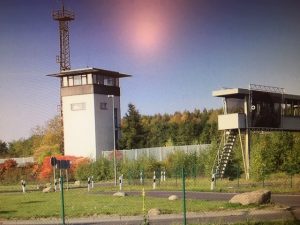
The wall was finally taken down in 1989, after days of protests following Gorbachev’s reform policies and not before 80 people had died trying to escape from the Soviet Communist regime. Countless others were injured whilst trying to flee. My cousin was one of those that had escaped to the West in the boot of her father’s car in 1961. She has a story to tell, but that’s for another day. During my time in Berlin, in the mid-70’s travelling around West Berlin it was always on public transport.

The U-bahn (Underground) would go through the Russian-controlled sector at Fredrichstrasse. Armed guards would be stationed at the end of the platform and trains would not stop there. You would see the watchtowers surrounding and the pale-complexioned, heavily-armed guards keeping a close eye on activities. Very spooky. My earliest recollection was of grey and drab streets outside and no advertisements anywhere.
Fast forward to nearly fifty years later, I found myself journeying to my cousin’s old family home near to the Wannsee lake at Klosterfelde. It took nearly 40 years but they now have legally secured the land that they previously owned in the East as a family. On the land is still the original, one-storey chalet-style cottage like a dacha that they had lived in. This is adjacent to a modern, two-storey house built in the last couple of years as a weekend retreat.
 Just up the road is the Wannsee residence of the former GDR leader, where Party functions were sometimes held. Erich Honeker was the Party supremo who lived the life of Riley using the George Orwell philosophy: “All animals are equal, but some are more equal than others”! After German reunification he claimed political asylum in the Chilean embassy in Moscow but was extradited back to Germany to face charges of human rights abuse committed by the East German government. However, proceedings were abandoned on grounds of illness and he was subsequently allowed to join his family in Chile where he died of liver cancer in 1994.
Just up the road is the Wannsee residence of the former GDR leader, where Party functions were sometimes held. Erich Honeker was the Party supremo who lived the life of Riley using the George Orwell philosophy: “All animals are equal, but some are more equal than others”! After German reunification he claimed political asylum in the Chilean embassy in Moscow but was extradited back to Germany to face charges of human rights abuse committed by the East German government. However, proceedings were abandoned on grounds of illness and he was subsequently allowed to join his family in Chile where he died of liver cancer in 1994.

 Fascinating stuff, the history of the GDR. No part of it is complete without mention of the Trabi. The Trabant was another People’s Car, but built in Zwickau in the East. With bodywork made from recycled wool or cotton, this piece of machinery first produced in 1959 had no fuel gauge, no indicators and a two-stroke engine. Not even a heated rear screen on which to keep your hands warm when pushing it. Over its 30-year production run, the price of a Trabant rose to the equivalent of one year’s salary (US$1,864 or now around US$15,000) for a typical worker. This had to be paid in full, in advance. The average waiting period for such an icon was 10 years. Despite its problems, nearly 3 million were produced before production ceased in 1989. There are still around 30,000 in existence.
Fascinating stuff, the history of the GDR. No part of it is complete without mention of the Trabi. The Trabant was another People’s Car, but built in Zwickau in the East. With bodywork made from recycled wool or cotton, this piece of machinery first produced in 1959 had no fuel gauge, no indicators and a two-stroke engine. Not even a heated rear screen on which to keep your hands warm when pushing it. Over its 30-year production run, the price of a Trabant rose to the equivalent of one year’s salary (US$1,864 or now around US$15,000) for a typical worker. This had to be paid in full, in advance. The average waiting period for such an icon was 10 years. Despite its problems, nearly 3 million were produced before production ceased in 1989. There are still around 30,000 in existence.
That’s quite enough about a pile of crap; back into the Grand Tourer and my current pride and joy, the Jag. Now began the final stage of the journey.
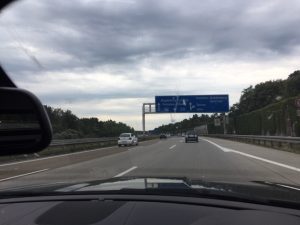 Day 8. The last part of my trip found me heading out of the city around the Avus Ring, part of the Berlin ring road system. Built in 1921, it is the oldest controlled-access highway in Europe. Until 1998, it was also used as a motor racing circuit. It now forms the northern part of Autobahn A115, linking Berlin via the A2 with Magdeburg and then Hannover.
Day 8. The last part of my trip found me heading out of the city around the Avus Ring, part of the Berlin ring road system. Built in 1921, it is the oldest controlled-access highway in Europe. Until 1998, it was also used as a motor racing circuit. It now forms the northern part of Autobahn A115, linking Berlin via the A2 with Magdeburg and then Hannover.
I came off the Autobahn at Helmstadt, the old transit point stop into and out of the former East Germany. I did this so that I could take a quick detour into Wolfsburg, the spiritual home of VW, near to where I would stay as a boy. No transit fees this time, nor long delays at the crossing point, simply a chance to revisit the past. However, no time to linger, as I had a ferry to catch and was running out of time.
Another 480 miles down the road and eight hours later, despite heavy rains, I reached the final destination on my continental journey, the Hook of Holland and the Stena Brittanica.
Quite painless, quick and very comfortable the XK had performed effortlessly and beyond expectations. Having carried me some 1,983 miles across Europe in eight very sunny and warm days, I couldn’t think of a better companion to spend the time with (apart from my wife of course!!). My only complaint is that the sat-nav system is hard to read in bright sunlight and its position is far from ideal, causing one to look down instead of viewing the road ahead. Still a lot easier than reading maps and notes across the front seat.
Thinking of next year, the Spluegen Pass linking Switzerland and Italy via Lake Como springs to mind, virus and travel corridors permitting. I can’t wait to check this out and cross it off the list of epic journeys to do!
Ian Croxson

